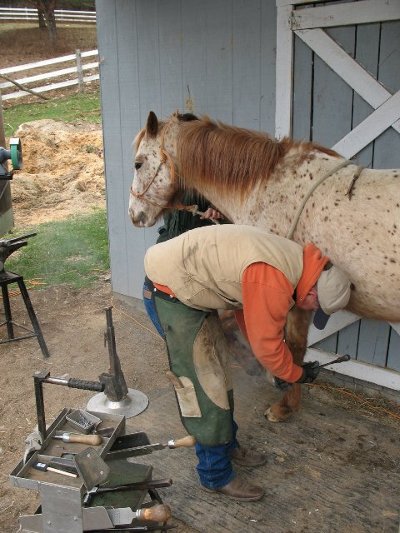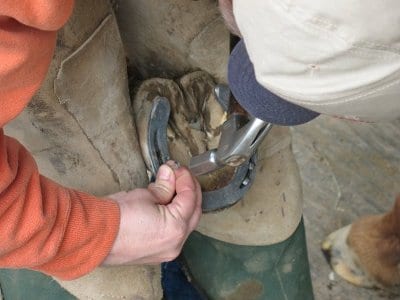
Once again we return to our So You Want My Job series, in which we interview men who are employed in desirable jobs and ask them about the reality of their work and for advice on how men can live their dream.
Today we hear from Zach Williams who is a professional farrier. The job title may not sound familiar to many modern men, but it’s a profession that’s been around for hundreds of years and involves an uber-manly combination of horses, tools, and blacksmithing. If you like animals, working with your hands, and shooting the breeze with Mr. Ed, this might be the job for you.
1. Tell us a little about yourself (Where are you from? How old are you? How long have you been doing your job, ect).
I was born and raised in Augusta County, Virginia in the heart of the Shenandoah Valley. I just turned 29. I’ve been a farrier for a little over 5 years.
2.Many men have probably never even heard the word “farrier.†What exactly does a farrier do?
A farrier trims horses feet to put them back in correct balance. We also apply horseshoes as needed and some farriers do corrective or therapeutic shoeing.
3. Why did you want to become a farrier?
Because my wife and I (at the time, we owned 3 horses) had a difficult time finding a reliable farrier that would show up when scheduled. I rode along with other farriers just to learn enough of the basics in order to take care of my own horses. By the end of the second day of riding with another farrier, I told my wife, “I can do this and pick up business from those farriers who are not reliable and not properly servicing their clients.†Also, I enjoy working outside, and I love horses and a rural lifestyle. I also get to meet a lot of really nice people.
4. When did you know it was what you wanted to do?
After bull riding didn’t quite work out like I had hoped—I had 3 orthopedic surgeries within 4 years due to broken bones! Though I won the Virginia pro-circuit bullriding championship, the downtime from the injuries was just too much.
5. Being a farrier is a pretty unique job-how did you find your way into the profession?
I grew up in a farming community and was active in 4H, so I was around farm animals, and my wife grew up riding and showing horses. She owned two horses when we got married. After I bought my first horse (while in rehab from a bullriding injury), I really grew to love horses—they’re beautiful animals.

5. How does a man become a farrier? Are there schools that teach you how to be one? Do you apprentice with someone to learn the job?
On the job training (apprenticing), schooling, or a combination of both—which is what I did. Yes, there are a number of good schools in the United States. Going to a good school is one of the best ways to start as you gain a lot of knowledge quickly. Apprenticing is a longer route to gain the same amount of knowledge, though one can also pick the trade up that way. Apprenticing also exposes you to horse people and gives you a unique, hands-on perspective of the trade. Both methods require lots of hours in front of an anvil and forge and lots of hours under many horses. Apprenticing is, in some ways, the most important part of your learning experience.
6. Once you become a farrier, how do you go about finding jobs and getting people to hire you to tend their horses?
The best way is to offer to ride with established farriers to help or to apprentice. By helping them out when they’re busy, you will pick up a client here and there, word of mouth, etc. I went to a lot of horse shows as well. More experienced farriers will often send you horses they don’t want to shoe—the mean ones: the kickers and biters, but like many other trades, you have to start at the bottom. Over time, your reputation grows—assuming you’re good—and you move up the ladder, so to speak.
7. Is it a very competitive business or are good farriers in demand?
That is specific to the location. In my area, the Shenandoah Valley, it is very competitive but there are also a lot of horses too. Oddly enough, competition drives prices higher in the farrier business, which is counterintuitive to what you would think. This is due to the fact that this type of a market draws higher skilled farriers who can demand higher prices for their services.
7. Is being a farrier something you can do as a full-time job? Or do have to do other jobs as well on the side?
It’s all I do, though starting out I did have to supplement my income with other jobs. Within 2 years, I was shoeing full-time. I’m able to fully support my wife and 2 daughters with the income from my farrier business.
8. What is the best part of your job?
The best part of my job are the occasions that I get to do therapeutic work on lame horses and the satisfaction that comes from being able to make a lame or injured horse better or, at the very least, more comfortable.
9. What is the worst part of your job?
The frustration that comes from having to deal with some horse owners and their poor horsemanship.
10. What’s the work/family/life balance like?
It can be very challenging because the area I work in has a large population of horses and during the busiest time of the year (March through November), I am constantly getting phone calls—even from those who aren’t my regular clients. You have to learn to say no or you’ll be out to midnight every night. Early on, I determined that unless it was an emergency, I would not work on Sundays. I’m also trying to schedule most Saturdays off to spend time with my family.
11. What is the biggest misconception people have about your job?
The biggest misconception is that folks think every dime they pay me stays in my pocket. But I have a lot of expenses such as fuel, horseshoes, nails, rasps. Just the raw material cost to shoe one horse (all fours) is about $20.00.
12. Any other advice, tips, or anecdotes you’d like to share?
To anyone starting out, don’t ever lose focus that it’s all about care for the horse. And don’t neglect to improve your basic horsemanship skills, along with your farrier skills.
Tags: So You Want My Job

